 |
 |
 |
 |
 |
 |
 |
 |
 |
|---|
Pin Identification
In this hobby there is more then meets the eye when it comes to knowing the history of the pins in your collection. If your surfing ebay, social media or at a local pinevent have you ever wondered what mesh, grid, eyeball, boxed. small print/large print or 4LC & 3LT meant? On the older pins that have the pinclasp feature on the back of the pin this terminology comes into play. There are many variations on pin backs & if your just starting in this hobby these terms may get confusing to you. Let's begin w/the different types of pin manufacturers & their designs.
Gift Creations Incorporation
American based company. At one time all HRC America /International & non-franchised locations sold GCI pins at their respective cafes. Early pins were made in Taiwan & later manufacturing came from China. Stampings on the back of these pins indicated their origin.
 |
 |
Eyeball
back made in Taiwan |
Grid
back made in China |
These pin back designs were the most common that GCI produced for pins being sold from the late 1980's to the mid 2000's. Eyeball, grid, mesh & weave were eventually replaced by the Hard Rock logo back design w/the pin clasp feature. In the early 2000's the tac back design was introduced & still used today.
 |
 |
| Eyeball
back - used in the early HRA/HRI days when some of the first cafes began
to sell pins |
Grid
back - produced in various designs the grid back was used for many USA/Europe/Mexican/Asian
based pins |
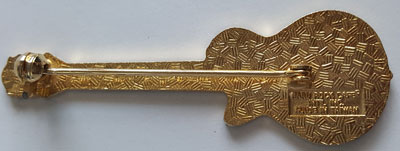 |
 |
Weave
back - only found for select USA pins the weave design appeared during
the transition from enamel to cloisonné pins |
Mesh
back - very common early design for USA/Europe based pins |
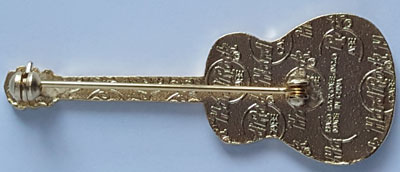 |
| Later
in production GCI produced a common back for most of their pins &
is HRC logo'd back |
In addition to the basic design differences that GCI produced there were several other differences that can make identical pins (front view) collectible from what is stamped on the back of the pin. One element is the size of where GCI put their production information (known as a box) in.
 |
|
From
left to right: small, medium & large boxes
|
Of the five main design backs from above the grid has the most differences as far as the size & how close the pattern is to each other.
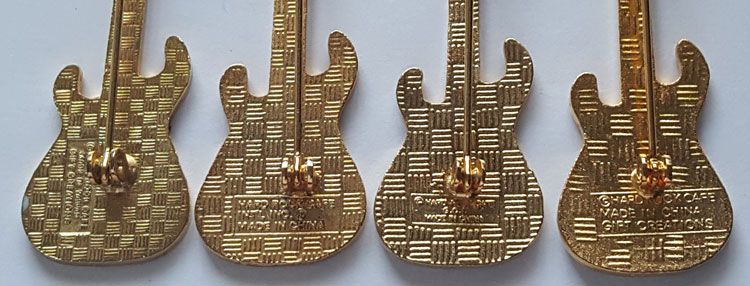 |
| From
left to right: small squared, medium, large & large open. The large
grid (#3) has a tight pattern in comparison to the pin to its right
where the pattern is very loose. For some collectors its very hard to
figure out the difference from a medium to large grid |
The HRC logo'd pin back also can be found in a few different variations w/the focus on how the box is presented. Some pins will have the box depressed, outlined, non-outlined or just a different size. Also pin manufactured from China can be stamped w/China or Made in China.
 |
 |
| From
left to right: boxed, non-boxed, large depressed box & smaller depressed
box |
"China"
& "Made in China" 1LC's |
 |
| The
early GCI pins were produced w/the locking clasp back but later the
tac back design has become the standard for today's HRC pins |
Another variation is the amount of lines or text w/I the box itself. If the pin was made in Taiwan it is known as "T" & China made is "C". So if a pin has 2 lines of text & made in China it's known as a 2LC, 3 lines 3LC & so on. Most Taiwan produced pins have the 3LT stamp & generally known as early GCI produced pins.
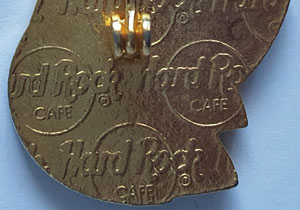 |
|
| 0
lines |
1
line or 1LC |
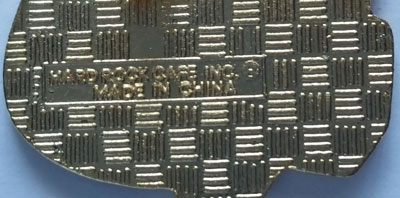 |
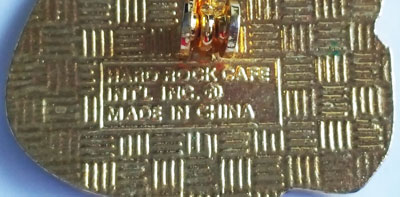 |
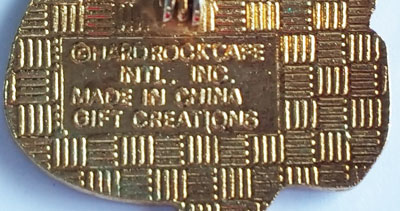 |
| 2
lines or 2LC |
3
lines or 3LC |
4
lines or 4LC |
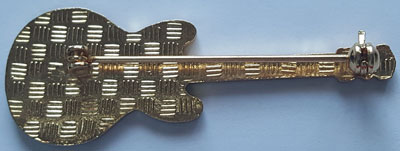 |
| Often
were prototypes were produced no back stamping was made until approved |
Even though Gift Creations made many pins for different HRC locations, they did not cover all areas of the world for pin distribution. Other manufacturers include FC Parry, Idea, Thorncraft, Hi-Tai, Pin USA & Zechovoy to name a few.
FC Parry
Based out of London, England, FC Parry (FCP) produced many of the early pins when HRC first began to sell pins at their cafes especially the London cafe as this was the very first cafe opened in 1971. Other cafes such as Stockholm, Tokyo, Dallas, Reykjavik & Cancun sold FCP guitar pins when these cafes first opened & sold pins to the public.
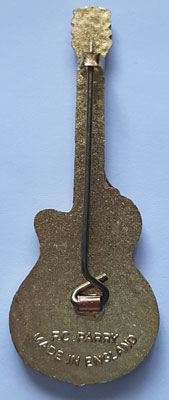 |
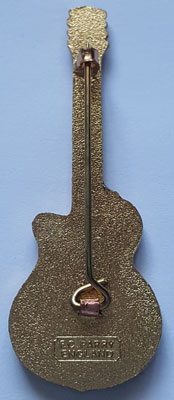 |
|
Known
as a "large print" back due the script being spelled out is
considered to be the older version of FCP pins |
With
the FCP info located in a small box this pin is known as the "boxed"
version & very common |
 |
1
line w/a smooth back |
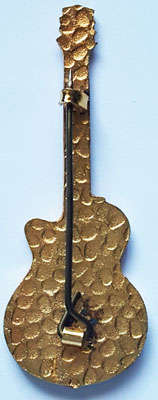 |
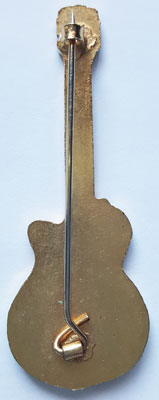 |
| Possibly
a prototype type back design, the "nugget" back was never
produced in large amounts |
Very
early FCP pins had this smooth back w/no script |
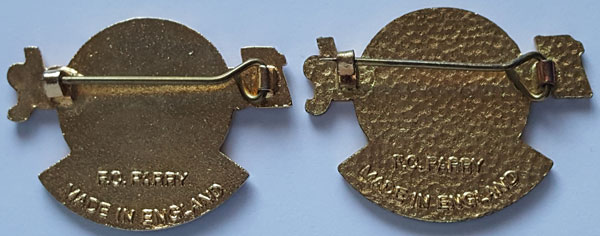 |
|
FCP
also made different back designs through out the years. Here you can
see a smooth back (left) & their pebble back (right)
|
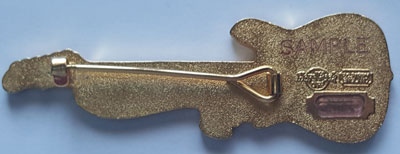 |
| When
FCP produced a prototype they stamped "sample" on the back.
Many samples were made until approved by the cafe or FCP |
Idea
Starting in 1993 Idea pins were produced for Mexican cafes. In early 1995 discontinued their relationship w/Idea for retail pins but still used them for Sterling Silver Staff pins.
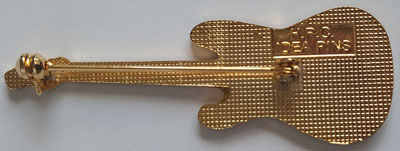 |
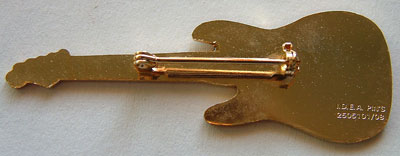 |
| Mesh
back |
Smooth
back |
Thorncraft
Many of the early pins that were available at the Reykjavik Cafe were produced by a local Iceland company called Thorncraft. They were unique as they were all hand casted & painted
 |
|
The
word "Thorncraft" is written on the neck of the guitar
|
Canadian Pins
There have been many manufacturers providing pins to the Canadian cafes ever since Toronto opened in 1978. such as Mills, Shilo & Pin USA. Prior to 1997 Canadian cafes were not part of HRC International & had to use Canada manufacturers to supply pins for all of the country's cafes. This time was known as "preunification" for their logo was a different design then other HRC cafes. Then from 1997 to 2000 all Canadian cafes reached an agreement w/HRC International & pins were now made by GCI.
 |
| Mills
pins were made in Ontario |
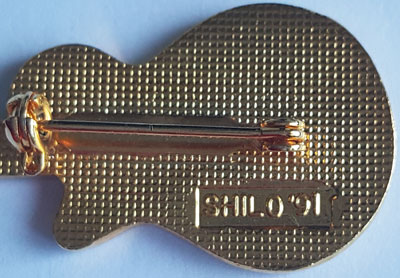 |
| Shilo
produced pins from 1990 - 1996 |
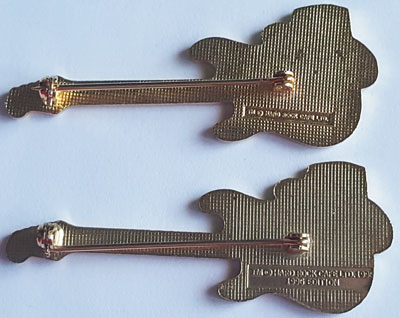 |
| Pins
had a mesh back & either had one or two lines of text as well being
dated |
 |
 |
| Made
in Canada |
Made
in China |
Pin USA
Starting in the late 1990's Pin Pals made many of the pins found in most HRC locations. It wasn't until the early 2000's that Pin USA took over as the main supplier for pins for HRC operations & Pin Pals was no longer used.
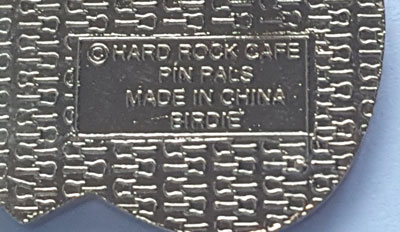 |
| Pin
Pals helped HRC is providing many pins when the hobby was starting to
get popular with new collectors |
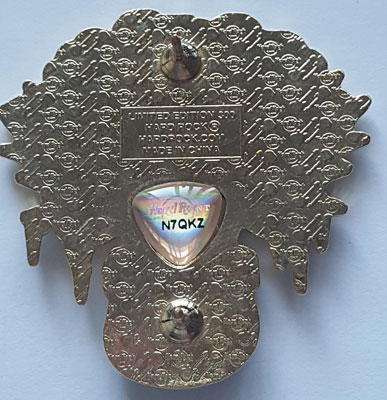 |
Hologram's
were first introduced from Pin USA to help cut down on the numerous
fake pins being made |
 |
| Different
metal bases were introduced to help determine quantity made & if
they were staff issued or not. London's 44th from retail (L) staff under
10 years & over 10 years of service |
Hi- Tai
 |
| Several
Asian HRC's used Hi-Tai as their producer. Early pins provided their
phone number (right) on the back |
Skyline
 |
|
Skyline
produced some pins for Buenos Aires
|
Zechovoy
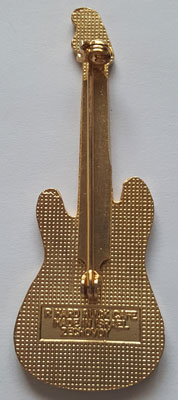 |
|
The
Israelian producer Zechovoy made pins for the Tel Aviv cafe in addition
to some from Gift Creations.
|
One particular cafe used many different manufacturers in the late 1990's to when the cafe closed & the rumor that the Tijuana Cafe was producing a new pin a week for collectors
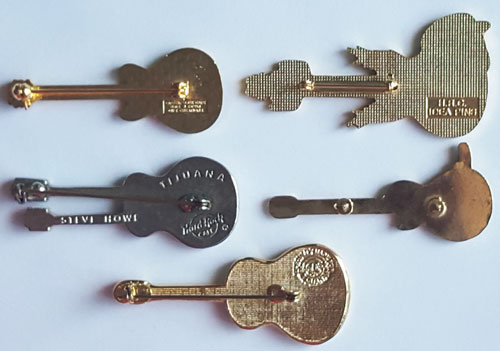 |
| Idea,
GCI & local manufacturers produced large volumes of high quality
pins until the cafe closed in 2008 |